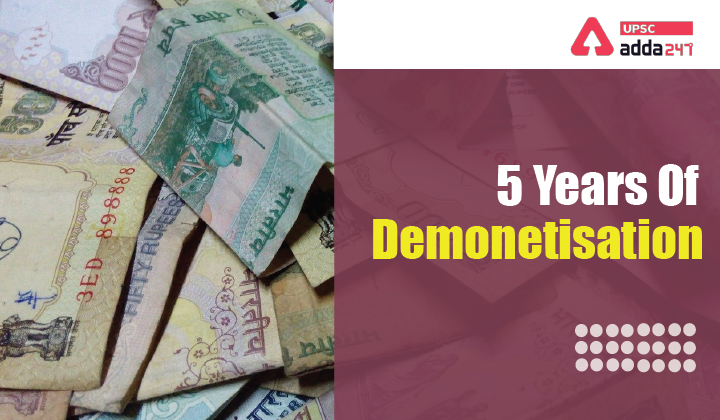Table of Contents
Relevance
- GS 3: Indian Economy and issues relating to planning, mobilization, of resources, growth, development and employment.
Have you cleared UPSC CSE Prelims 2021? Register Here for Free Study Material
Context
- November 8, 2021 marked five years of demonetisation in India. On this day in 2016, our Prime Minister declared that currency notes of ₹500 and ₹1000 would cease to be legal tender. A process that is called demonetisation.
Transition to Green Energy: Challenges Before the Indian Economy!
5 indicators to show what has changed after 5 years of demonetisation
- Cash flow in the system: Circulation of cash in the economy touched all-time high of Rs 28.3 trillion on October this year.
- Digital transactions: Digital transactions that include UPI, PhonePay, Paytm, among other merchants have also witnessed an all-time high.
- UPI Transactions: UPI transactions have been increased form just 0.29 million in Nov 2016 to 4.2 billion now.
- Value of UPI transactions: UPI has also recorded highest transaction of $103 billion last month.
- Currency in circulation: Currency in the economy is growing with the nominal GDP growth.
1000 Day Plan for 1 trillion Dollar Digital Economy
What has demonetisation achieved?
- A Harvard University working paper finds that demonetization led to a permanent increase in the use of digital transactions, especially among the young.
- COVID 19: Less cash in the economy has allowed people to order essential items during home isolation and made payment through online medium using various apps.
- Increase in online transactions, and GST have led to formalisation of the economy.
- The number and value of ITRs and employees in formal sector rose after demonetisation.
- If informal economy shrank, black money would have come down too.
However, demonetisation has often been criticised as a failed decision due to following reasons
- Killing black money was the prime target of demonetisation. However, according the RBI data, almost the entire chunk of money (more than 99 per cent) that was invalidated came to the banking system.
- Fake notes: In 2016, 6.32 lakh counterfeit pieces were seized across the country. In the next four years, a total of 18. 87 lakh pieces of fake notes have been seized across the country in various denominations, according to the RBI data.
- Demonetisation lowered the growth rate of economic activity by at least 2 percentage points in the quarter of demonetization.
- The worst impacted were segments that relied on high-volume cash transaction, such as organized and unorganized retail.
- An IMF report states that the disruption caused by cash shortages dampened consumer and business sentiments, leading to a decline in high-frequency consumption and production indicators, such as sales of two-wheelers and cement output, respectively.




 TSPSC Group 1 Question Paper 2024, Downl...
TSPSC Group 1 Question Paper 2024, Downl...
 TSPSC Group 1 Answer key 2024 Out, Downl...
TSPSC Group 1 Answer key 2024 Out, Downl...
 UPSC Prelims 2024 Question Paper, Downlo...
UPSC Prelims 2024 Question Paper, Downlo...





